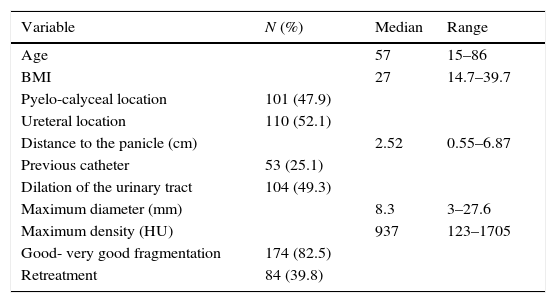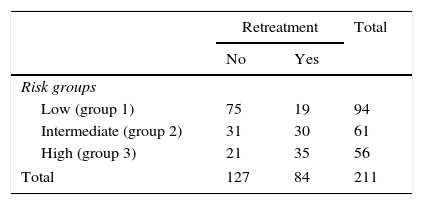Extracorporeal shock wave lithotripsy (ESWL) is a non-invasive, safe and effective treatment for urinary tract lithiasis. Its effectiveness varies depending on the location and size of the stones as well as other factors; several sessions are occasionally required. The objective is to attempt to predict its success or failure, when the influential variables are known beforehand.
Material and methodsWe analyzed 211 patients who had had previous CT scans and were treated with ESWL between 2010 and 2014. The influential variables in requiring retreatment were studied using binary logistic regression models (univariate and multivariate analysis): maximum density, maximum diameter, area, location, disintegration and distance from the adipose panniculus. With the influential variables, a risk model was designed by assessing all possible combinations with logistic regression (version 20.0 IBM SPSS).
ResultsThe independent influential variables on the need for retreatment are: maximum density >864 HU, maximum diameter >7.5mm and pyelocaliceal location. Using these variables, the best model includes 3 risk groups with a probability of requiring significantly different retreatment: group 1 – low risk (0 variables) with 20.2%; group 2 – intermediate risk (1–2 variables) with 49.2%; and group 3 – high risk (3 variables) with 62.5%.
ConclusionsThe density, maximum diameter and pyelocaliceal location of the stones are determinant factors in terms of the effectiveness of treatment with ESWL. Using these variables, which can be obtained in advance of deciding on a treatment, the designed risk model provides a precise approach in choosing the most appropriate treatment for each particular case.
La litotricia extracorpórea por ondas de choque (LEOC) es un tratamiento no invasivo, seguro y efectivo para las litiasis del tracto urinario cuya efectividad varía según la localización y el tamaño del cálculo, entre otros factores; en ocasiones es necesario realizar varias sesiones. El objetivo es tratar de predecir el éxito o fracaso conociendo previamente las variables influyentes.
Material y métodosAnalizamos a 211 pacientes con TAC previa entre aquellos tratados mediante LEOC entre los años 2010 y 2014. Se estudian las variables influyentes en la necesidad de retratamiento utilizando modelos de regresión logística binaria (estudio uni- y multivariado): densidad máxima, diámetro máximo, área, localización, desintegración y distancia del panículo adiposo. Con las variables influyentes se ha diseñado un modelo de riesgo valorando con regresión logística todas las posibles combinaciones (IBM SPSS versión 20.0).
ResultadosLas variables de influencia independiente en la necesidad de retratamiento son: densidad máxima >864 UH, diámetro máximo >7,5mm y localización pielocalicial. Utilizando estas variables, el mejor modelo incluye 3 grupos de riesgo con probabilidades de necesitar retratamiento significativamente diferentes: grupo 1-bajo riesgo (0 variables) con 20,2%, grupo 2-riesgo intermedio (1-2 variables) con 49,2% y grupo 3-alto riesgo (3 variables) con 62,5%.
ConclusionesLa densidad, el diámetro máximo y la localización pielocalicial del cálculo son factores determinantes en la efectividad del tratamiento con LEOC. Con estas variables, que se pueden obtener antes de la decisión terapéutica, el modelo de riesgo diseñado permite una aproximación precisa de cara a elegir el tratamiento más adecuado para cada caso en particular.













